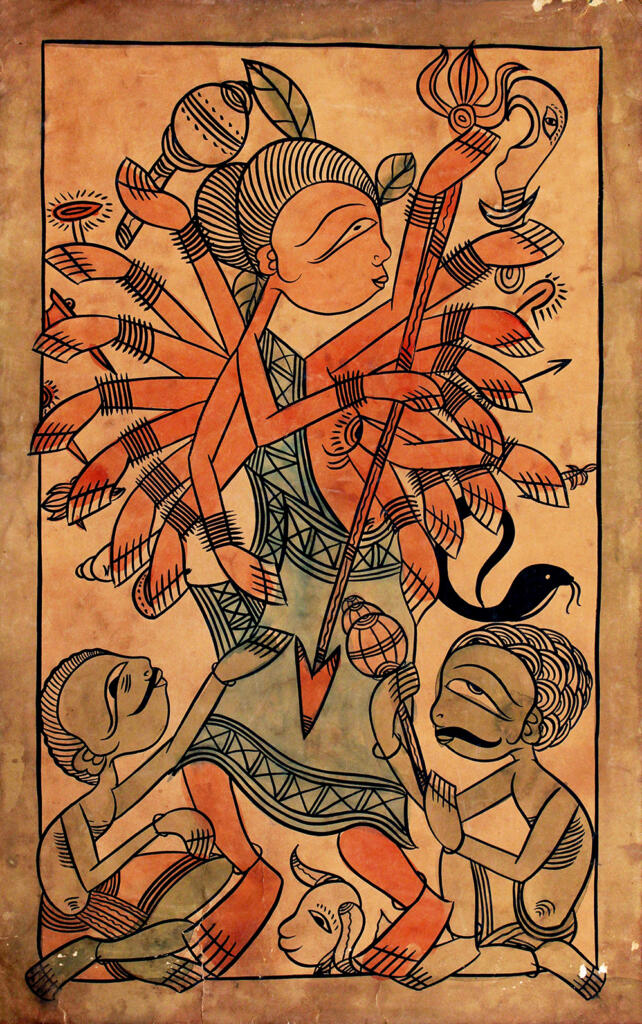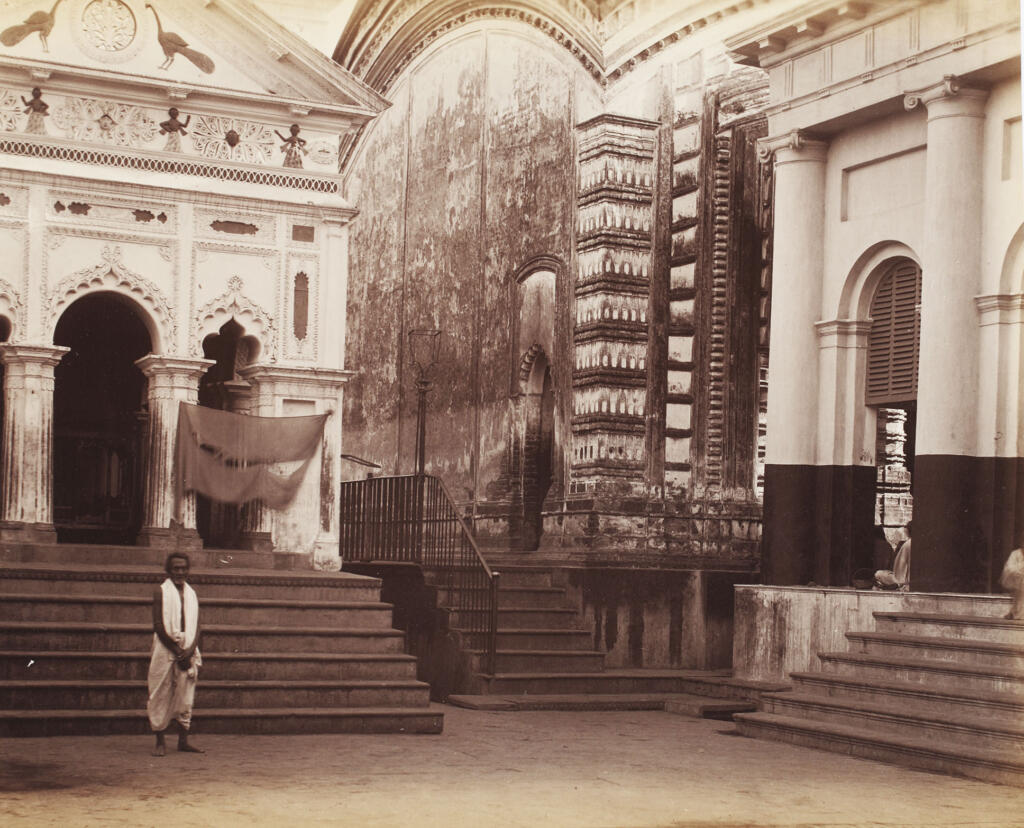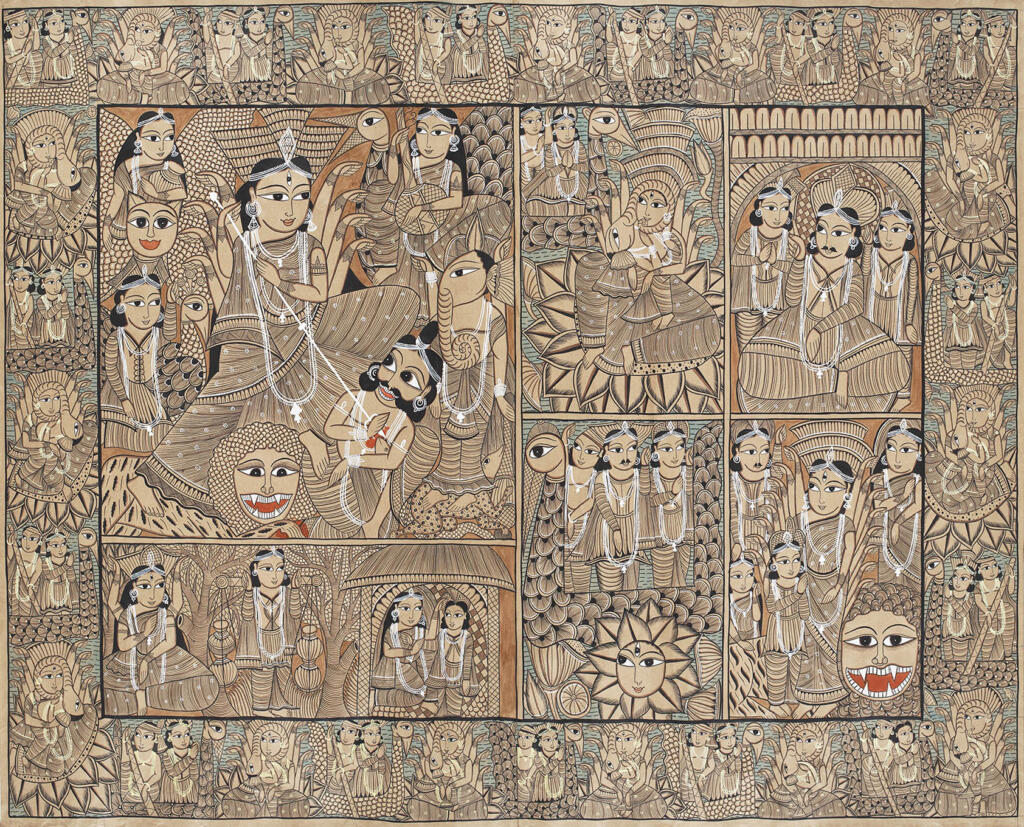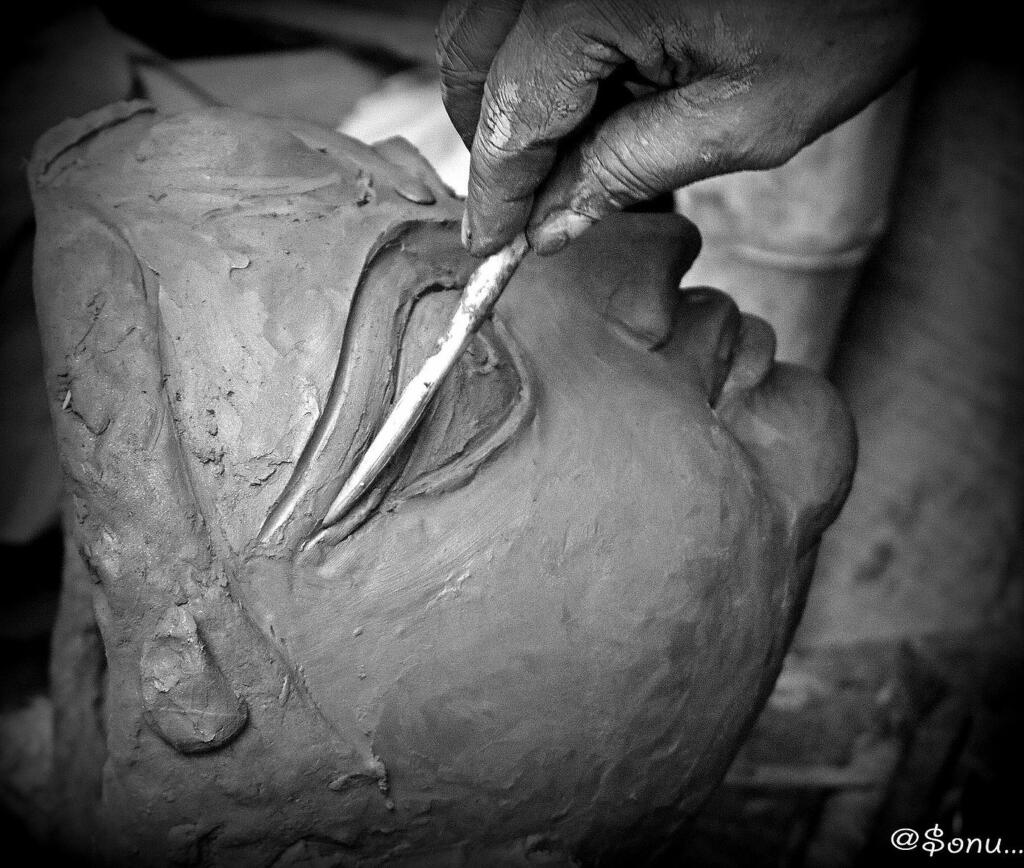
Mahishasur Mardini, Midnapore Folk Art, undated, Natural colour on paper pasted on cloth, unidentified artist ©️Sarmaya Arts Foundation
All the best superheroes have an enigmatic past tinged with violence and redemption. Think Black Widow, Wonder Woman, Batman. But Bengal’s beloved Ma Durga could beat them hollow with nine hands tied behind her back. A tireless warrior, a solitary crusader, a beacon of hope, this goddess is all that and so much more; Lord Shiva alone is believed to have 108 names describing her grace, power and supremacy. Over time, Durga has morphed and grown to cover new dominions and take new identities.
Experts say it’s impossible to trace the origin of the Durga we know today to an specific time or place. However, it’s widely accepted that the idea of her originated in tribal mythology. Early mentions of her are found in the fifth century, where the Puranas describe a dark-skinned, four-headed deity called Kumari Bramacharini who kills the demon Mahishasura and resides in the Vindhyas. Interestingly, here Durga is associated with cowherds and the worship of Lord Krishna.

Entrance to the Kalighat Kali Temple, Calcutta, c.1890-1930, by unidentified photographer ©️Sarmaya Arts Foundation
In the seventh century, a goddess by the name of Vindhyavasini Kali is mentioned in the Puranic texts. She is said to have been worshipped by non-Aryans, who made her offerings of wine and blood. But by this time, the text of Devi Mahatmyam had effectively folded Durga into the Brahminical pantheon. She was given various names including Chamundi, Shakti and Kali; seen as an avatar of Parvati, wife of Shiva; and branded as the demon-slaying warrior queen. Her greatest victory remained the vanquishing of the buffalo-demon, Mahishasur.
In the centuries to come, the goddess began to take on a composite identity that was informed by various regional influences as well as elements of Tantra and Buddhism. And in Bengal, where goddess worship was always prevalent, new aspects of Durga’s personality emerged. By the 16th to 17th centuries, her mythology had responded to and been transformed by the prevailing Bhakti movement and oral storytelling traditions. The blood-thirsty protector also began to be seen as adored daughter, virtuous wife and benevolent mother.

Untitled (Durga worship), undated, Tempera on paper pasted on cloth, unidentified artist ©️Sarmaya Arts Foundation
Speaking of storytelling traditions, in her paper, Goddess encounters: Mughals, Monsters and the Goddess in Bengal, Kumkum Chatterjee notes that, “The Bengali Mangalkavya genre also functioned as an important catalyst in the process of the ‘softening’ of the goddess.” The Mangalkavyas consist of devotional songs that cast folk and other local goddesses in a human light. Deities like the snake goddess Manasa feature prominently in these stories. Even today, Bengal Pattachitra artists draw inspiration from this body of literature to create and perform their art.
If the currents of faith and culture in Bengal shaped Durga’s mythology, Calcutta’s famous pujo season cemented her status as the people’s goddess. The autumnal festival is celebrated in the lunar month of Aswin and its appeal is universal, cutting across lines of caste, class and community. Durga pujo is believed to have begun as a harvest festival in rural Bengal, when rich zamindars would host the entire village as a form of thanksgiving. Some accounts date its arrival in the area that would later be christened Calcutta to the year 1606, when the Sabarna Choudhuris of Barisha hosted a family puja. The custom would be restricted to the courtyards of rich families till the end of the 18th century when a few villages came together to host a cultural event at Guptipura. This new kind of pujo was accompanied with all sorts of live entertainment and the trend travelled back to Calcutta, which was by then established as the prosperous centre of British rule in India. How could some of its cosmopolitan razzle-dazzle not rub off on the Durga pujo.
From a family affair, the pujo turned into a sarbojanin or community event. By the 20th century, each para or locality would set up a pandal housing the goddess. The deity changed too; Durga was now accompanied by her four children, the goddesses Lakshmi and Saraswati and gods Ganesha and Kartikeya. Detached from its agrarian roots, pujo came to be seen as a celebration of the mother-goddess’s annual return to her maternal home. During the struggle for India’s freedom from British rule, it would serve yet another purpose. Bengali nationalists used this popular public platform to get their message out without attracting the state’s attention.

From a potter’s studio in Kumortuli, Kolkata, image courtesy Wikipedia Creative Commons/Debnathsonu1996
Today, the zamindar has been replaced by political and corporate sponsors with much deeper pockets and wider ambitions. Every year, the ingenious potters of Kumortuli find breathtakingly original ways to do justice to the towering legend of Ma Durga. And even a global pandemic might not rob the sheen of pujo season; there are plans to organise a drive-in event this year that allows contactless pandal-hopping. To a Bengali, a year without Durga pujo is unthinkable. It would like a summer without mangoes. Or biryani without potatoes. Or a goddess without her people.
We end with a more recent development in the still-evolving story of Ma Durga. Over the past few years, a group of tribal Indians who carry the surname Asur and claim to have descended from Mahishasur himself, mark the day of Durga pujo by mourning the death of their martyr. Thus adding another layer of complexity to the mythology of the goddess. Her origins as an tribal deity of the forest, her entrance in the Hindu pantheon, her journey from village to city, her status from fringe to mainstream and now, her story told through the voice of her victim. There’s never a dull moment when the goddess comes to town.
References:
Durga: Her Origin and History by BC Mazumdar
Goddess: Durga in Perspective by Sayantani Dasgupta
Goddess encounters: Mughals, Monsters and the Goddess in Bengal by Kumkum Chatterjee
Spaces of Recognition: Puja and Power in Contemporary Calcutta by Anjan Ghosh



